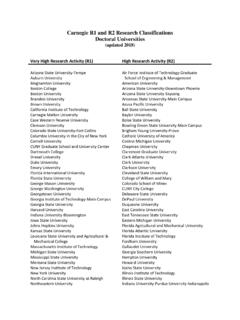Transcription of Boltzmann’s Entropy Equation - University of New …
1 1 boltzmann s Entropy EquationlnSkW=The Entropy and the number of microstates of a specific system are connected through the boltzmann s Entropy Equation (1896):0S 2ndLaw of Termodynamics:For a closed system, Entropy can only increase, it can never an irreversible process the Entropy a reversible process the change in Entropy is DefinitionsThe configurationof a system is some measurable state in which the system resides. Example1: 6 molecules are distributed 4 on the left, 2 on the : A gas on n mole in a volume V has temperature T and pressure number of microstatesfor a configuration is the number of ways in which the configuration can be put together. This number of ways is called the multiplicity, W, of the find the number of microstates by counting them. There are mathematical methods for counting (combinatorics) that help us. The factorial(N!) is one such tool. N! is the number of ways in which Nitems (particles, spin states) can be arranged.
2 It is equal to: N!=N*(N-1)*(N-2)..(2)*(1). When counting microstates, we have to be careful to not count states twice (or more). Since usually we deal with molecules that can not be distinguished from each other (since they are identical) we need to make sure we divide out all the ways in which the molecules can be arranged in their particles in a box, no division between left and right. Then the number of microstates is:60!160!W==Ten particles in a box, with 2 distinct sides, so a particle is either on the left or on the right. We have 6 particles on the left, 4 on the right:10!2106!4!W==Ten particles in a box, with 3 distinct regions, left, middle, right, filled with 5,3,2 particles !25205!3!2!W==One hundred particles in a box, 10 regions, each region has 10 particles:()9210100! 1010!W==iEntropy Thermodynamic ViewRudolf Clausius (1865): Entropy is the amount of thermal energy put into a system that can not be extracted as ST = = In a cyclic process, you can convert heat in to work ( a steam engine).
3 However, you can never convert all the heat fully into work, some of it is constant temperature we have:QST =3 Entropy as State FunctionIf Entropy is a state function, then the Entropy of a system is the same whenever it is in the same state. Thus a cyclic process must have S=0. For an ideal gas we can write down the change in Entropy between 2 states as:lnlnffViiVTSnRnCVT =+ EnginesIn a thermodynamic sense, engines turn heat into work. No engine can convert all the heat at the input into work, some heat must be discharged. Thus, and engine needs a hot reservoir for heat input, and a cold reservoir for heat output. You cannot extract work when you have no temperature Ideal Engine:For any ideal engine we use a gas that does work in a cyclic process, each step of this process is reversible, thus for one full cycle, for the gas: P=0, V=0, T=0, Eint=0, S= EngineIdeal Carnot Engine:In a Carnot Engine the gas absorbs heat during an isothermal expansion at TH, then adiabatically expands to TL, then releases heat during an isothermal contraction at TL, and finally contracts further adiabatically to come back to the initial temperature THProperties:int0 HLEWQWQQ = = = 00 HLHLHLHLHLQQQ QSS STTT T = + = = =11 HLLLCHHHHWQQQTQQQT === =

